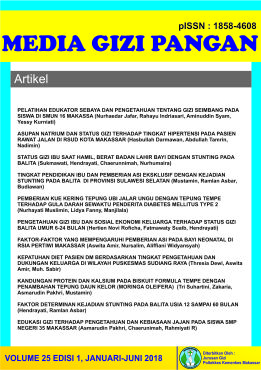HUBUNGAN PERSONAL HYGIENE, RIWAYAT PENYAKIT INFEKSI DAN ASUPAN PROTEIN DENGAN KEJADIAN STUNTING PADA BALITA USIA 6-24 BULAN
Personal hygiene, history of infectional diseases with incidents of stunting in toddler ages 6-24 months
DOI:
https://doi.org/10.32382/mgp.v31i1.569Kata Kunci:
Asupan Protein, Personal Hygiene, Penyakit Infeksi, StuntingAbstrak
The stunting rate in Indonesia is still relatively high, reaching 21.6% in 2022, including one district in South Sulawesi, namely Jeneponto Regency, where the stunting rate is still high, namely 39.8%. On the other hand, personal hygiene, history of infectious diseases and protein intake are still considered poor. This study aims to determine the relationship between personal hygiene, history of infectious diseases and protein intake with the incidence of stunting. This research is a cross sectional study. The sample for this research was 80 toddlers aged 6-24 months. This research was conducted in Bontomatene Village, Jeneponto Regency. The research instruments were a questionnaire and recall form. The analysis used is the chi square test. The results of the analysis showed that most of the samples had good personal hygiene, 73.8% and 26.2% had poor personal hygiene. History of infectious disease in the Yes category was 68.8% and the No category was 31.2%. Poor protein intake is 50% and 50% is good. The results of statistical tests show that there is no relationship between personal hygiene and the incidence of stunting (p= 0.810), there is no relationship between a history of infectious disease and the incidence of stunting (p= 0.672) and there is a relationship between protein intake and the incidence of stunting (p= 0.002) in the village Bontomatene, Jeneponto Regency. Mothers and caregivers need to increase their children's protein intake by feeding them animal and vegetable protein sources according to their age requirements, through the use of local foods.
Referensi
Abidin, S.W. et al. (2021) ‘Hubungan Sanitasi Lingkungan Dan Riwayat Penyakit Infeksi Dengan Kejadian Stunting Di Kota Parepare, 6(August 2020), pp. 7–14.
Desyanti and Amertu, N.(2017)‘Hubungan Riwayat Penyakit Diare dan Praktik Higiene dengan Kejadian Stunting pada Balita Usia 24-59 Bulan di Wilayah Kerja Puskesmas Simolawang, pp.243–251.Available at: https://doi.org/10.20473
Intan Suseni, N. putu, Tat, F. and Djogo Azi, herlianan monika (2022) ‘Kejadian Stunting Pada Balita Di Wilayah Kerja Puskesmas Kilasah Serang Banten’, Jurnal Dunia Kesmas, 8(1), pp. 45–52.
Kemenkes RI (2022) ‘Kepmenkes RI no HK.01.07/MENKES/1928/2022 Tentang Pedoman Nasional Pelayanan Kedokteran Tata Laksana Stunting’, pp. 1–52.
Nindya, T.S. (2017) ‘Asupan Energi , Protein dan Lemak dengan Kejadian Gizi Kurang pada Balita Usia 24-59 Bulan di Desa Suci, Gresik, pp. 341–350. Available at: https://doi.org/10.20473/amnt.v1.i4.2017.341-350.
Nurun Hikmah, D. (2021) ‘Analisis Personal Hygiene Dengan Kejadian Scabies Pada Santri Di Pondok Pesantren’,Jurnal Ilmiah 12(3), pp. 1–6. Available at: https://stikes-nhm.e-journal.id/NU/article/view/466.
Pitaloka Putri, M., Mangalik, G. and Dary (2022) ‘Asupan Protein, Zat Besi Dan Status Gizi Pada Remaja Putri’, Journal of Nutrition College, 11(1), pp. 6–17. Available at: http://ejournal3.undip.ac.id/index.php/jnc/.
Rismawatiningsih, W. et al. (2023) ‘Hubungan Faktor Sanitasi Lingkungan Dan Personal Hygiene Dengan Kejadian Stunting Pada Balita Di Wilayah Kerja Puskesmas Rejosari Pekanbaru Tahun 2022'
Sumartini, E. (2022) ‘Studi Literatur : Riwayat Penyakit Infeksi Dan Stunting Pada Balita, STIKes’, 9(1), pp.55–62. Available at:https://doi.org/10.54867.
Syarifah, L.M. (2023) ‘Hasil Survei Status Gizi Indonesia (SSGI) 2022’.
Unduhan
Diterbitkan
Terbitan
Bagian
Lisensi
Hak Cipta (c) 2024 Nadimin, Adriyani Adam, Sirajuddin, Umniatul Rafiah

Artikel ini berlisensi Creative Commons Attribution-NonCommercial-NoDerivatives 4.0 International License.
PDF downloaded: 286










